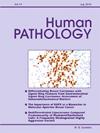TSC2免疫组化测定在TSC/mTOR通路改变的肾脏肿瘤中的遗传学验证
IF 2.7
2区 医学
Q2 PATHOLOGY
引用次数: 0
摘要
结节性硬化症复合体(TSC)/mTOR通路相关基因的致病突变与组织学上多种多样的肾细胞肿瘤有关,包括嗜酸性实性和囊性肾细胞癌(ESC RCC)、低级别肿瘤(LOT)、嗜酸性空泡瘤(EVT)和黄疽性巨细胞肾细胞癌(XGC RCC)。在此,我们通过比较这些肿瘤的基因组数据,验证了 TSC2 免疫组织化学(IHC)检测方法。我们对 38 例经基因证实的 TSC/mTOR 相关肾肿瘤(6 例 ESC、16 例 EVT、13 例 LOT、2 例 XGC 和 1 例透明细胞 RCC)的福尔马林固定石蜡包埋(FFPE)组织进行了自动 TSC2 IHC 检测,并与内部对照组织进行了半二分法视觉评分。TSC2蛋白缺失对TSC2潜在致病突变的阳性预测值(PPV)为92%(11/12),而通过IHC检测完整TSC2对TSC2缺乏潜在致病突变的阴性预测值(NPV)为81%(21/26)。通过IHC检测完整的TSC2对缺乏潜在致病性TSC2突变的特异性为95%(21/22)。所有缺乏TSC2突变且TSC2蛋白完整的病例都存在TSC1、MTOR或PIK3CA的潜在突变。TSC2缺失对潜在TSC2截断突变的敏感度为77%(10/13),对潜在TSC2错义突变的敏感度为33%(1/3)。总体而言,73%(8/11)的肿瘤存在TSC2 IHC缺失和潜在的TSC2致病性改变,表现为异质性蛋白缺失,肿瘤细胞中存在罕见的穿插阳性染色。这些数据支持将TSC2 IHC作为一种潜在有用的检测方法,用于诊断疑似属于TSC/mTOR相关亚组的肾脏肿瘤。本文章由计算机程序翻译,如有差异,请以英文原文为准。
Genetic validation of a TSC2 immunohistochemistry assay in TSC/mTOR-pathway altered renal tumors
Pathogenic mutations in the genes associated with tuberous sclerosis complex (TSC)/mTOR pathway are linked to histologically diverse renal cell neoplasms, including eosinophilic solid and cystic renal cell carcinoma (ESC RCC), low grade oncocytic tumor (LOT), eosinophilic vacuolated tumor (EVT), and xanthomatous giant cell renal cell carcinoma (XGC RCC). Here, we validate a TSC2 immunohistochemistry (IHC) assay by comparison to genomic data in these neoplasms. Automated TSC2 IHC was performed on formalin-fixed paraffin embedded (FFPE) tissues from 38 genetically-confirmed TSC/mTOR-associated renal tumors (6 ESCs, 16 EVTs, 13 LOTs, 2 XGC and 1 clear cell RCC) and visually scored in a semi-dichotomous fashion compared to internal control tissue. The positive predictive value (PPV) of TSC2 protein loss for underlying pathogenic mutation in TSC2 was 92% (11/12), while the negative predictive value (NPV) of intact TSC2 by IHC for lack of underlying pathogenic mutation in TSC2 was 81% (21/26). Intact TSC2 by IHC was 95% (21/22) specific for absence of underlying pathogenic TSC2 mutation. All the cases lacking TSC2 mutation with intact TSC2 protein had an underlying mutation in TSC1, MTOR or PIK3CA. Loss of TSC2 was 77% (10/13) sensitive for underlying TSC2 truncation mutations and 33% (1/3) sensitive for underlying TSC2 missense mutations. Overall, 73% (8/11) tumors with TSC2 IHC loss and underlying pathogenic alterations in TSC2 showed heterogeneous protein loss, with rare interspersed positively staining tumor cells. These data support TSC2 IHC as a potentially useful assay for the diagnostic workup of renal tumors suspected to belong to the TSC/mTOR-associated subgroups.
求助全文
通过发布文献求助,成功后即可免费获取论文全文。
去求助
来源期刊

Human pathology
医学-病理学
CiteScore
5.30
自引率
6.10%
发文量
206
审稿时长
21 days
期刊介绍:
Human Pathology is designed to bring information of clinicopathologic significance to human disease to the laboratory and clinical physician. It presents information drawn from morphologic and clinical laboratory studies with direct relevance to the understanding of human diseases. Papers published concern morphologic and clinicopathologic observations, reviews of diseases, analyses of problems in pathology, significant collections of case material and advances in concepts or techniques of value in the analysis and diagnosis of disease. Theoretical and experimental pathology and molecular biology pertinent to human disease are included. This critical journal is well illustrated with exceptional reproductions of photomicrographs and microscopic anatomy.
 求助内容:
求助内容: 应助结果提醒方式:
应助结果提醒方式:


